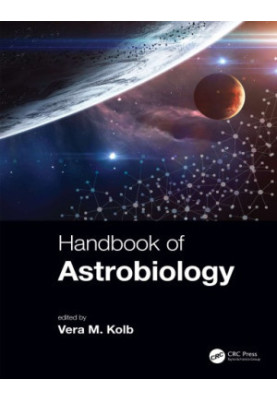Handbook of astrobiology
 Моментальне завантаження
Моментальне завантаження
після оплати (24/7)
 Широкий вибір форматів
Широкий вибір форматів
(для всіх пристроїв)
 Повна версія книги
Повна версія книги
(в т.ч. для Apple та Android)
Astrobiology is defined as the study of the origin, evolution,distribution, and future of life in the universe (NASA’s definition;Des Marais et al. 2008). Astrobiology seeks to answerfundamental questions about the beginning and evolution oflife on Earth, possible existence of extraterrestrial life, andthe future of life on Earth and beyond. Astrobiology scope isdelineated in the NASA’s astrobiology roadmap (Des Maraiset al. 2008). Specific goals include understanding the emergenceof life on Earth, determining how the early life onEarth interacted and evolved with its changing environment,understanding the evolutionary mechanisms and environmentallimits of life, exploring habitable environments in our solarsystem and searching for life, understanding the nature anddistribution of habitable environments in the universe, andrecognizing signatures of life on the early Earth and on otherworlds. The NASA’s astrobiology map is being updated asthe astrobiology field advances. A similar roadmap has beendeveloped for astrobiology research in Europe (Horneck et al.2015, 2016). The topic of these roadmaps is further discussedand updated in Section 1 of this handbook.Astrobiology is a young science that acquired its nameonly in 1995 (named by Wes Huntress from NASA; Catling2013). Astrobiology evolved from its predecessor, exobiology,which is the study of the origin of life and of possiblelife outside Earth (Dick and Strick 2004; Dick 2007). Theterm exobiology was coined in 1960 (by Joshua Lederberg).The difference between the two fields is that astrobiology isbroader and notably includes the evolution of life on Earth.The exobiology era coincided with the space missions, notablythe Viking mission on Mars in 1976, which followed aseries of reconnaissance missions in the 1960s and early1970s. The Viking mission searched for the microbial life onMars (DiGregorio 1997; Jones 2004), but it did not confirmits existence. The early experiments that used radio astronomyto search for extraterrestrial intelligence by the Searchfor Extraterrestrial Intelligence (SETI) program (Tarter 2007)did not result in positive findings. In 1996, the analysis of theMartian meteorite ALH84001, which was found in Antarctica,indicated possible presence of the fossils of bacterial life(Goldsmith 1997; Jones 2004), but the results were not convincingenough. Disappointments regarding a lack of positiveresults in the search for extraterrestrial life (Dick and Strick2004; Dick 2007, 2012) continue to this date. The only life weknow of is the life on Earth. Search for extraterrestrial life andextraterrestrial intelligence is further discussed in Sections 10through 12 of this handbook.While astrobiology is a new science, it comes froma very old and long history of ideas, which go all the wayback to the antiquity. The history of one of the core ideasof astrobiology, a possibility of extraterrestrial life, isdescribed in the books: “Plurality of worlds: The originsof the extraterrestrial life debate from Democritus to Kant”(Dick 1984), “The extraterrestrial life debate, 1750–1900”(Crowe 1999), “Medieval cosmology: Theories of infinity,place, time, void, and the plurality of worlds” (Duhem 1987),and other sources. A comprehensive coverage of the ideasabout extraterrestrial intelligent life is covered in the books:“Extraterrestrials: Science and alien intelligence” (Regis1987), “Extraterrestrials: Where are they?” (Zuckermanand Hart 1995), “Beyond contact: A guide to SETI andcommunicating with alien civilizations” (McConnell 2001),and “Civilizations beyond Earth: Extraterrestrial life andsociety” (Vakoch and Harrison 2013), among other sources.The future of life on Earth and its potential uniqueness arediscussed in the books “The life and death of planet Earth:How the new science of astrobiology charts the ultimate fateof our world” (Ward and Brownlee 2002), and “Rare Earth:Why complex life is uncommon in the universe” (Ward andBrownlee 2004). Search for exoplanets, some of which maybe habitable, is a subject of recent studies (Kasting 2010;Summers and Trefil 2017). This subject is further covered inSection 12 of this handbook.The major hypothesis about the origin of life on Earth,which later became accepted as a key foundation of both exobiologyand astrobiology, was proposed independently by A.I.Oparin in 1924 and J. B. S. Haldane in 1929 (Oparin 1965,1968, 1994; Deamer and Fleischaker 1994; Haldane 1994).This hypothesis states that the origin of life on Earth can beunderstood based only on the laws of chemistry and physics.Life arose in Earth’s distant past by chemical reactions andphysical processes under the specific conditions on the earlyEarth and over a long period of time. Numerous rapid developmentsbased on the Oparin–Haldane proposal followed(Miller and Orgel 1974; Mason 1991; Brack 2000; Zubay2000; Chela-Flores 2001, 2011; Fenchel 2002; Lurquin 2003;Gilmour and Sephton 2004; Luisi 2006; Sullivan and Baross2007; Sullivan and Carney 2007; Kolb 2014a; Longstaff2015). New developments on chemical origins of life andprebiotic chemistry are covered in Section 5 of this handbook.
LF/718120/R
Характеристики
- ФІО Автора
- Ed
Kolb
Vera M - Мова
- Англійська
- ISBN
- 9781351661096
- Дата виходу
- 2019










![[87th Precinct 33] • Calypso](https://lionbook.net/1430818-thickbox_default/-87th-precinct-33-calypso.jpg)




![[A Taipei Night Market 01]...](https://lionbook.net/1705800-thickbox_default/-a-taipei-night-market-01-ghost-month.jpg)










